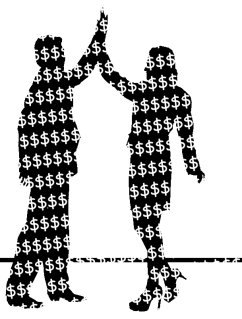At a Glance: The 2016 US Economy and Some of its Implications
In order to keep my long term plans feasible and my expectations realistic, I like to take a look at broad economic conditions at the end of every year. Doing so helps me know whether to launch some big new project, hunker down and focus on stuff I've already got going, or free up resources for new opportunities which are not yet visible. Overall, I read what I'm seeing this year as potentially quite volatile, which suggests that it may be a good year to modify existing projects or free up resources for future work, but may not be a good year to launch any new long term endeavors which call for any measure of economic climate stability. Since average people and small businesses constitute the bulk of those my work serves, my focus here is on on the big picture as experienced by those near the bottom of the food chain.
Heading into 2017, 95 million eligible workers in the US are not adequately employed in the formal economy and the average cost of living continues to increase by nearly 10% annually. Debt is hilariously high, and may be largely unpayable. This is what an unsustainable economy looks like.
Overview
In response to this year's November jobs report, a recent New York Times article notes that the US economy "... put another 178,000 people on payrolls last month and pushed the unemployment rate down to 4.6 percent today from 4.9 percent the previous month. Wage growth, though slower, is still running ahead of inflation ..."
Of course, the "unemployment rate" that the NYT is referring to is the U-3 number, which measures only very short term unemployment. And the 178,000 people put on payrolls last month seems downright unimpressive when held against the 446,000 people who stopped "participating in the labor force" during the same time frame. This brings the total number of Americans now counted as "not in the labor force" to over 95 million. Even with an officially reported 5.5 million job openings and a 'job openings rate' of 3.7 percent, this is an astonishingly high figure - particularly when held against the possibility raised by ShadowStats accounting method that well over 20 percent of eligible US workers are not currently adequately employed.
It is also worth mentioning that the "inflation" figure cited in the above-referenced NYT article is based on the government's Consumer Price Index (CPI). According to BLS data, "Over the last 12 months, the all items index rose 1.6 percent". But this overall figure has been kept artificially low for the last thirty years to prevent government outlays from increasing too quickly, which masks the real inflation rate as experienced by average people. Rents alone are up 3.9% over last year, and costs associated with medicine, education, and other basic stuff are through the roof. The Chapwood Index, which provides a far more accurate measure of inflation, reports the actual rate to be near or above 10 percent in nearly all major US cities.
While the US GDP stands at an apparently robust $16.77 trillion, total US household debt (including mortgages, auto loans and student loans) now equals almost $12.4 trillion. Student loan debt alone has grown by a trillion dollars in the last decade to about $1.3 trillion, and nearly half of those who owe money on these debts are not making any payments on them.
Meanwhile, trillions upon trillions of unfunded pension obligations have combined into a pension tsunami that is gathering momentum and endangering the retirement plans of millions. And, in a sign of things to come, the US government has started capturing revenue by charging exorbitant fees for the service of directly servicing unpayable student loan debts by garnishing social security payments.
Discussion
As described in a previous post, social and technological trends are combining to broadly reconfigure the total economy. This is to some extent hidden by the huge disconnect between misleading government reports and the overall data. Also, the overall data itself may be of increasingly low quality as a combination of government and corporate policies force more and more people out of the formal economy and into the informal sector.
These sorts of conditions rapidly grow inequality. They produce big winners (like the security industry), big losers (like those attempting to pay for traditional college educations, save money with average incomes, or retire), and extremely varietal, highly localized outcomes. Major investments that have long appeared safe may suddenly fail to produce anticipated returns, causing the actions that people, companies, and institutions take to capture what they believe they are owed - or just to maintain cash flow through socially and politically turbulent times - to snowball into systemic disruptions with little warning.
Of course, as the actual cost of living continues to dramatically outpace increases in average workers' earnings, and as those within the growing poverty class find that poverty itself is increasingly a crime, most people will have far more to worry about than the prospect of systemic disruptions until these begin to materialize in a directly relevant way.

Winter is coming